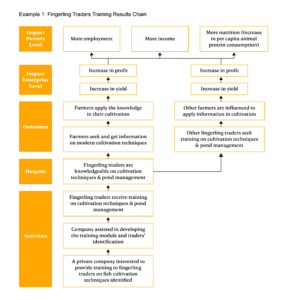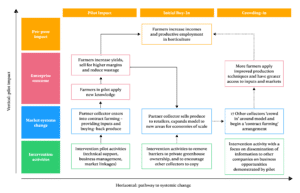Results chains
PDF Download: Results Chains
In a nutshell: Results chains are a visual tool for showing what a project is doing and why. They explain all the links in the chain from project actions to market actor changes, through to impacts on target groups, in detail, for a particular intervention. They can be used to monitor change and adapt strategy on an ongoing basis.
Status: Optional tool
Key principles: Results chains need to remember the principle of Facilitation – which can be difficult when trying to predict a series of changes and to attribute the cause of those changes to the project. What is important is to remember that ultimately the market system exists and operates regardless of our presence. The best we can hope for as facilitators is to influence it in a positive direction. Similarly, for a results chain to align with Systems Thinking, it’s important to thoroughly document assumptions and keep in mind other influences that can lead to unexpected responses or changes. Results chains can be designed to reflect Gender, allowing a project to disaggregate change as it affects men and women.
Preconditions and preparation: You will need to have a detailed market analysis and information on specific market actors and their incentives. It is useful to develop results chains at the same time as developing interventions and partnerships, so that you clarify the logic of each intervention and ensure the results chain is relevant to the specific strategy you are taking.
Timeline and resources: Developing results chains is a specialised skill – usually held by Monitoring & Evaluation (M&E) experts. However, it is important to have a strong partnership between staff who lead interventions and those who work in M&E – to develop the best results chains. Once a results chain is developed, it can be used on an ongoing basis. Regular review meetings can assess progress and the chain, and the project’s activities, can be adapted as necessary.
Useful Tips
Produce a coherent causal model
- Explain how the intervention contributes to the results
- Avoid dead ends
Be logical
- Make every arrow meaningful
- Indicate the direction of expected change
- Clearly show sequential and consequential progression
Communicate clearly
- Focus on the key elements
- Avoid too many arrows and feedback loops
- Remove anything that does not add meaning
- Ensure readability
- Avoid trigger words or mysterious acronyms
Outputs
The results chain itself is a visualisation of linked changes, as shown in the example below. The best way to start developing a results chain is to simply list the activities and changes in boxes, and add additional detail until the full set of linked changes is elaborated. It is less important what the ‘categories’ for the boxes are (e.g. activity vs. output vs. outcome vs. impact). In fact, some more useful categories may include:
- (a) project intervention;
- (b) market actor change;
- (c) market system change;
- (d) change in services/products for target groups;
- (e) change in poverty/outcomes for target groups.

Example 2: Contract farming example

Outcomes/behaviour changes
Results chains are most impactful when they are used as a tool for learning and adaptive management. By specifying the intended strategy in sufficient detail, they enable collection of data that can help projects know what changes are (and are not) taking place and why. This can then support targeted changes of direction and adaptations to interventions. Programme teams can review results chains, checking assumptions, progress and making adaptations on a regular basis. In this way, they help the programme adjust to more impactful strategies. Your final results chain may look very different to your first one!
Resources and templates:
DCED Standard Implementation Guidelines on Results Chains [PDF]
Case studies including this tool:
DCED Case Studies